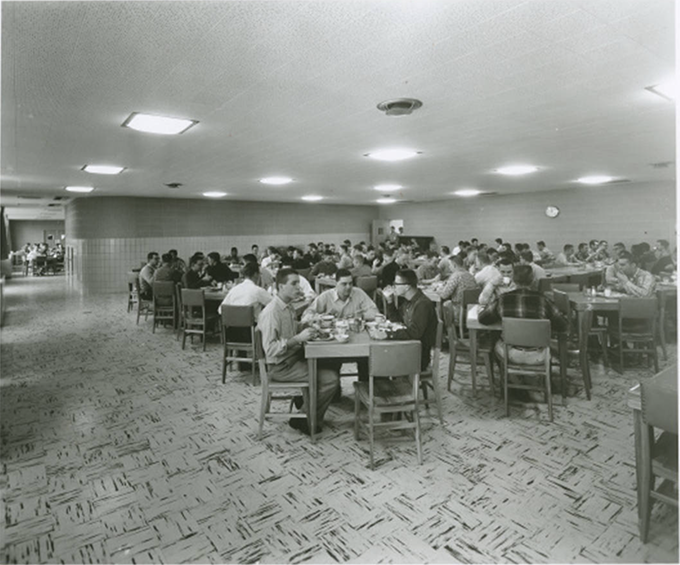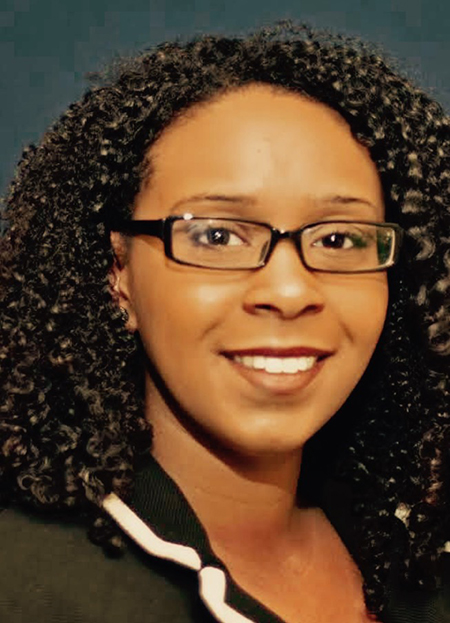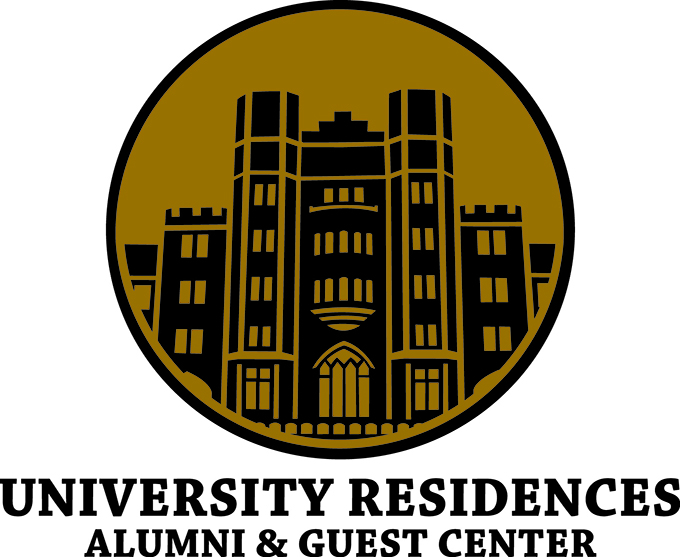
August 2018

University officials at the unofficial groundbreaking on the construction of Hillenbrand Hall. From left: Marilyn Yoder, John Sautter, Sarah Johnson, Dale Daniels, Lanny Wilson, Sue Graham and Tim Gennett.
Hall Profile
Hillenbrand Hall Celebrates 25 Years of Innovation
During Fall 2018, Hillenbrand Hall will celebrate its 25th anniversary of being at the forefront of innovation in campus living and learning. The anniversary offers us an opportunity to look back on where we’ve been and look forward to what is to come.
The early-1990s brought about a need for new housing at the University with the scheduled demolition of Fowler and Terry Courts. Each of these buildings had housed students since the mid-1950s and were slated to be demolished at the end of the 1992-93 school year. Terry Courts were located at the site of what is now Discovery Park; the site of Fowler Courts was later repurposed for the construction of First Street Towers. Fowler House, which served as the kitchen and dining area for Fowler Courts, is still in use by the Department of Child Development and Family Studies.

Students dine in Terry Courts. Photo Courtesy of Purdue University Libraries, Karnes Archives and Special Collections

Students walk through a courtyard in Fowler Courts. Photo Courtesy of Purdue University Libraries, Karnes Archives and Special Collections
The new residence hall would be the first new housing construction on campus since the completion of Shreve Hall in 1970. The project presented an opportunity for University Residences to redefine the residence hall experience of future Boilermakers. Incorporating suggestions from student focus groups and input committees, Hillenbrand would feature a move away from institutional-style housing, emphasizing flexibility and style. The residence hall received its name in honor of John and William A. Hillenbrand, a father and son who each served as members of the Board of Truste
Perhaps the most noticeable change was designing the hall with co-ed residency in mind, which was later implemented. The change, as standard as it may sound now, was initially met with some resistance at higher levels due to the tradition of separate housing for male and female students. Co-ed housing is now a standard accounted for with all new University Residences construction.
“The initial reaction at the time was along the lines of ‘What have you been smoking?! This is Purdue!’” remarked Tim Gennett, a lead developer in new residential housing who worked at the University for 37 years.
Incorporated into the building plans were the first Purdue amenities to feature suite-style rooms with an adjoining bathroom. The rooms were decked with new furniture, including desks custom-built to handle the explosion of personal computers. Another departure from older residence hall models was furniture that could be moved by students into a custom layout, rather than the bolted-down furniture that equipped older halls.
Hillenbrand also became the site of a reimagined dining court concept. Taking the lead from the food industry service students had come to expect at restaurants, airports and malls, the Hillenbrand Dining Court completely scrapped the outdated cafeteria-style line in favor of a service that allowed students to choose from a variety of options. The dining court’s popularity was a catalyst for the University’s Campus Dining Master Plan that revolutionized the campus dining experience at Purdue. Hillenbrand was the last residence to be constructed with a dining hall contained within the residence hall.

In addition to serving students, the Hillenbrand Dining Court is used for awards presentations and student activities.
Interest in the opening of the hall built, helped along by tours of interest to showcase the hall during Day on Campus. The construction included several setbacks, including a strike by concrete workers, that delayed construction. A selfless effort by the hall’s food service employees helped ensure rooms were furnished on time for students in Fall 1993 as they unloaded 40 semi-truck loads of furnishings and equipment for rooms.
Upon completion, the Hillenbrand Dining Court instantly became the most popular place to dine on campus. Lines were consistently out the door as students queued to take advantage of the new style of dining service and plentiful food options. A bakery, known as Griffin Bakery, was a popular breakfast and snack stop among staff and students.
The success of Hillenbrand’s construction served as a model for other universities. Successful elements of its design have been incorporated into new construction at numerous other institutions of higher learning, including the University of Texas and University of Toledo. With new building standards, Hillenbrand Hall is designed to serve the University with longevity in mind.

The legacy of Hillenbrand is poised to take its next step with the launch of an innovative learning community known as The Data Mine. This learning community combines living, learning and research components to introduce students to data science and equip them with the tools to address problems posed by the explosion of data throughout society. Students will have the opportunity to create solutions to real-world problems as they live, study and research together.
The Data Mine community incorporates successful aspects of learning communities while simultaneously breaking the mold and expanding into new territory. While many universities have adopted the learning community-based approach to academic and residential partnerships, The Data Mine is unique in housing 14 data-themed communities under one roof, all of which include a research component.
The Data Mine currently houses 94 students in Hillenbrand Hall. University Residences officials project 10-14 learning communities, each housing 25-100 students, to be in place by 2019-20. The target goal for participation in The Data Mine is 800 students, all of whom will be housed in Hillenbrand.
Residents in The Data Mine will be able to take advantage of facility enhancements to Hillenbrand, including renovated study areas, technology upgrades, additional space to interact with faculty and a further commitment to use current space for academic purposes. Dr. Mark Daniel Ward, professor of statistics, for example, has relocated his office to Hillenbrand and will teach a statistics seminar in the atrium of the dining court. All renovations are designed to facilitate faculty-student interactions in the residential environment.
With the addition of The Data Mine, Hillenbrand is poised to continue to be at the forefront of innovation in University Residences. From its inception to its current position on the cutting edge of a new approach to academic and residential learning, Hillenbrand continues to embody the spirit of the “Giant Leaps” Purdue University has taken over the last 150 years.
Alumni Profile
Hillenbrand More Than Just a Place to Live for Moise

For Ashley Rozier Moise, living in Hillenbrand Hall was about more than just a roof over her head and a bed to sleep in.
“Hillenbrand was not just a place to live, but a place to learn,” said Moise. “Safety, study spaces, food and quality of life all came to together to create an experience that was really beneficial.”
Moise arrived on campus as a freshman in Fall 2006. She initially lived with a high school friend in Harrison Hall. When the two were thinking about where to live the following year, they decided on Hillenbrand for the convenient location, suite-style rooms and the dining court. She later obtained positions as a resident assistant and staff resident in Hillenbrand.
Moise explained that her interest in working as a resident assistant began during her freshman year when she took note of her own resident assistant’s involvement in the hall.
“It seemed like a pretty cool gig,” said Moise. “It was an obvious decision because it sounded great with the opportunity to work and live on campus. It was the perfect mixture.”
Living in Hillenbrand for three years allowed Moise to fully experience the hall’s culture both as a resident and as an employee. She fondly remembers being exposed to different cultures through events and interactions with other residents. Among the numerous cultural events she attended, a Chocolates of the World event that introduced students to chocolates from different parts of the globe sticks out as one of Moise’s favorites. A knitting program and the annual Thanksgiving feast also created memories that have stuck with Moise.
Resident assistant training provided opportunities to give back that Moise said she treasures. Service projects at a local domestic violence shelter and helping residents recover from flooding were among the projects Moise completed alongside her peers.
“Having that experience of giving back sets the tone for the bonding experience you have as RAs,” said Moise.
It was the studious and driven culture of the Hillenbrand’s residents, however, that stands out as the most important aspect of Moise’s experience in the hall. Being able to use the hall’s study areas and being able to live around students who were diligently pursuing different programs is something Moise said made a big difference for her. That culture proved especially beneficial when Moise was studying for the Law School Admission Test (LSAT).
“It was great to be around people with different, but similar goals,” said Moise. “Being around people who were passionate about doing well helped me succeed academically as a RA.”
Moise graduated from Purdue in 2010 with a political science degree. After graduating from Indiana University’s Maurer School of Law in 2013, she worked as the Deputy Prosecuting Attorney for the Marion County Prosecutor’s Office. She currently works as a staff attorney for the Indiana Supreme Court, Office of Court Services.
Alumni News
Alumni Meal Cards Available at UR Guest Center
Alumni Meal Cards are now available at the University Residences Alumni and Guest Center, located in Cary Quad. The guest center is open Monday through Friday from 9 a.m. to 4:30 p.m. and on Saturdays from 10 a.m. to 1 p.m.
If you cannot pick up your card during these times, please arrange an alternate pick up by calling 765-496-0278 or emailing urguestcenter@purdue.edu.
Writer: Matt Vader | Editors: Renee Kashawlic, Danielle Fawbush
Editorial Board: John Eckman, Renee Kashawlic | Inquiries Contact: studentlifemarketing@purdue.edu

